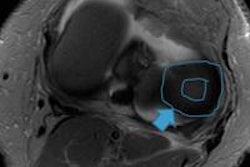A preliminary study has concluded that using a new 3D isotropic fast spin-echo (FSE) sequence to detect knee joint abnormalities could hasten the assessment of patients with severe pain or claustrophobia who cannot tolerate a 25-minute routine MRI exam, according to results published in the August issue of Radiology.
Researchers found that the 3D FSE sequence, called FSE-Cube, has similar diagnostic performance to a routine 2D MRI protocol, but takes just 20% of the time. They compared the techniques for a variety of knee pathologies, including cartilage lesions, cruciate ligament tears, collateral ligament tears, meniscal tears, and bone marrow edema lesions within the knee joint.
The lead author of the study was Dr. Richard Kijowski from the University of Wisconsin in Madison, with co-authors from Stanford University in Stanford, CA (Radiology, August 2009, Vol. 252: 2, pp. 486-495). One co-author was a GE employee, and a second co-author receives research support from GE, the authors disclosed.
A faster protocol
Conventional musculoskeletal MRI is based on 2D FSE sequences that are repeated in multiple planes, an approach that provides high in-plane spatial resolution but can lead to partial-volume artifacts due to gaps between sections, according to the authors. Using a 3D isotropic FSE sequence instead could reduce these artifacts by acquiring thin, continuous sections through joints.
Previous 3D isotropic FSE sequences were impractical due to their long acquisition and postprocessing times, but they are now clinically feasible thanks to advances in imaging techniques and more powerful MRI workstations, the authors wrote. The FSE-Cube sequence used in the Radiology study takes five minutes to perform, versus 25 minutes for the standard 2D FSE protocol.
The study group consisted of 100 consecutive patients who were imaged with a routine knee MRI protocol of multiplanar 2D FSE sequences and the FSE-Cube sequence, and who subsequently underwent arthroscopic knee surgery. There were 54 male patients, ranging in age from 16 to 66 years (median, 32), and 46 female patients, ranging in age from 16 to 79 years (median, 33).
The study did not exclude any patients based on any factors, such as age, weight, severity of knee injury, history of prior knee surgery, or quality of the MRI examination.
All 100 patients in the study group were imaged with the same 3-tesla MRI unit (Signa Excite HDx, GE Healthcare, Chalfont St. Giles, U.K.) using an eight-channel phased-array extremity coil (Precision Eight TX/TR high-resolution knee array, Invivo, Orlando, FL).
All MRI exams consisted of an axial frequency-selective fat-suppressed T2-weighted FSE sequence, a coronal intermediate-weighted FSE sequence, a coronal frequency-selective fat-suppressed intermediate-weighted FSE sequence, a sagittal intermediate-weighted FSE sequence, a sagittal frequency-selective fat-suppressed T2-weighted FSE sequence, and a sagittal FSE-Cube sequence.
Reader reviews
The MRI studies were independently reviewed twice in separate sittings by two fellowship-trained musculoskeletal radiologists, who were blinded to the arthroscopic findings in each patient.
After MR images were analyzed, the researchers found that in the detection of 189 cartilage lesions, FSE-Cube had significantly higher sensitivity, significantly lower specificity, and similar accuracy compared with the routine 2D MRI protocol.
The researchers found no statistically significant differences in sensitivity, specificity, and accuracy in detecting full-thickness and three partial-thickness anterior cruciate ligament tears, 52 medial meniscal tears, and 35 lateral meniscal tears for FSE-Cube versus the routine 2D MRI protocol.
3D isotropic FSE (FSE-Cube) versus standard 2D FSE protocols
|
||||||||||||||||||||||||||||||||||||||||||||||||||||||||||||||||||
| Note: Numbers in parentheses are the combined data from reviews of two readers. Source: Radiology, University of Wisconsin, Stanford University. |
||||||||||||||||||||||||||||||||||||||||||||||||||||||||||||||||||
FSE-Cube also had similar specificity and accuracy compared with the routine 2D MRI protocol for detecting posterior cruciate ligament tears. For both sensitivity and accuracy, FSE-Cube rated 99%, compared with 99.5% for routine MRI.
The researchers acknowledged several limitations to the study, including the small patient sample. Some results comparing the sensitivity for detecting each grade of cartilage lesion, the accuracy for detecting all cartilage lesions, and the sensitivity and specificity for detecting lateral meniscal tears between FSE-Cube and routine MRI were "not statistically significant," they wrote.
Additional studies
"For this reason, we believe that additional clinical studies with larger patient populations may be needed to detect subtle differences in the diagnostic performance of FSE-Cube and the routine MRI protocol," the authors wrote.
Because of the small sample, the researchers noted, two statistically significant results -- the higher sensitivity and lower specificity of FSE-Cube for detecting cartilage lesions -- "are not completely independent of one another and may be partially explained by the same underlying phenomena."
The group still was confident that the results show similar diagnostic performance between FSE-Cube and the routine 2D MRI protocol for detecting cartilage lesions, cruciate ligament tears, collateral ligament tears, meniscal tears, and bone marrow edema lesions.
The authors recommended FSE-Cube as a viable option for "rapid comprehensive knee joint assessment in patients with severe pain or claustrophobia who cannot tolerate a 25-minute routine MRI examination," with the caveat that "additional studies are needed to determine whether FSE-Cube can replace currently used 2D sequences for evaluating the knee joint in all patients undergoing routine MRI."
By Wayne Forrest
AuntMinnie.com staff writer
July 29, 2009
Related Reading
MRI helps develop novel plug for damaged knees, July 9, 2009
1T extremity MRI accurately shows knee disorders, June 24, 2009
Extremity 1T MRI equals 1.5T for rheumatoid arthritis, June 8, 2009
MRI helps find fractures among elderly female ED patients, April 29, 2009
3D isotropic MRI comparable to 2D MRI in knee imaging, February 18, 2009
Copyright © 2009 AuntMinnie.com



.fFmgij6Hin.png?auto=compress%2Cformat&fit=crop&h=100&q=70&w=100)




.fFmgij6Hin.png?auto=compress%2Cformat&fit=crop&h=167&q=70&w=250)











